












My research examines the importance of time to our perception of the landscape, while also considering the relationship of people to their environments. My video and photographic series, “The Color of Memory,” observes the elasticity of time and color, constructing a more arbitrary relationship between the two. The rearranging of color channels in multiple layered images illustrate the fracturing of our perception of color as a fixed entity and how time alters our understanding of the landscape. Misaligning the color plates within the images performs the same function as a prism, when refracting white light into the component colors, creating colorful ghosting where movement occurs.
“The Color of Memory” contains distinct sections, consisting of still photographs as well as both single channel and multiple channel video installations. In the work “The Color of Memory: Lunar Calendars,” the third section of this series, I study depictions of lunar phases by fracturing the white moonlight into its component colors. Lunar calendars are depictions of the changing phases of the moon, and a lunar phase is determined by the portion of the moon illuminated by the sun from the perspective of the earth’s surface. The source imagery for “Lunar Calendars” is appropriated from space agencies around the world. The act of appropriation from publicly funded organizations like NASA reinforces a universal ownership of the celestial object orbiting the earth. “Lunar Calendars” creates vibrant depictions of the moon by creating distortions within the relationships of the between the various color channels of each of the moon’s phases.